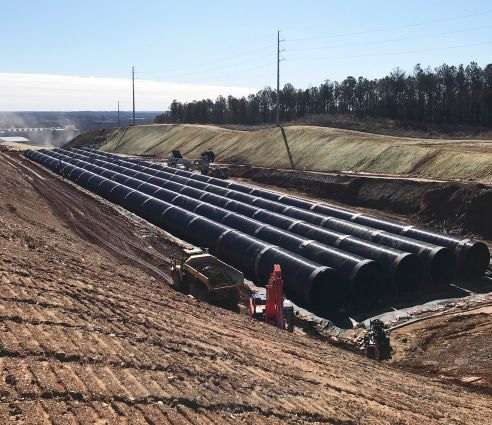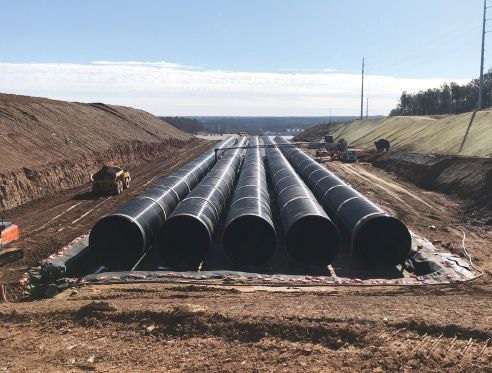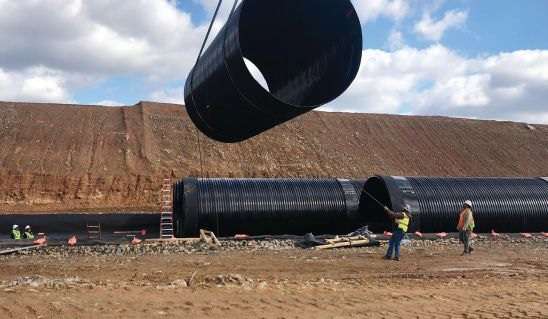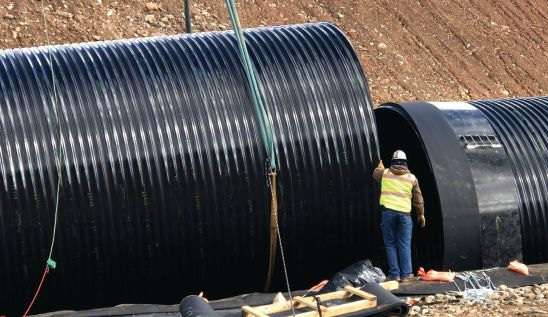Data Centers: Provide Unique Circumstances and Challenges for Stormwater Detention
E-commerce is fueling a need for data centers and warehouses that require massive stormwater treatment systems; and designing, manufacturing and installing these systems can require a different approach from other types of structures.
Site security is one factor that makes stormwater infrastructure projects for data centers unique, notes Glen Payton, P.E., CPSWQ, a stormwater consultant for Contech Engineered Solutions, which provides manufactured goods throughout the civil and engineering industry. The company’s stormwater group provides infrastructure support with stormwater management products. Besides its Filterra product, everything is provided for underground use.
“Site security from terrorists or similar threats, managed in part with non-disclosure agreements and control of site access by any and all outside suppliers, vendors and contractors” are differentiating factors, Payton points out. “Data centers are similar to military installations in their need for site security and reduced presence of outsiders during all phases of the project: concept, design, construction, and post-construction inspection and maintenance activity.”
Other differentiating factors include quick installation, long service life, easy and fast inspection processes, and maintenance processes that are quick and infrequent. These are necessary to minimize future onsite activities involving outside entities.
Size and Security Matter
A data center’s location presents a unique set of circumstances. Typically, the building size is massive, and its construction results in more impervious drainage areas with the potential to create significant post-construction runoff.
In such cases, Contech considers containing runoff to pre-construction conditions by designing a stormwater storage system for a Maximum Design Storm, which can be as high as the 100-year storm. Such was the case in an Atlanta project that necessitated storage of more than 4 million gallons (more than 500,000 cf).


A telescopic conveyor is used to backfill the detention system.
Cost-effective performance comes into play while respecting client site-security requirements, notes Payton, adding that ease of installation, inspection, and reasonable maintenance efforts and frequency often are paramount. Given these goals, quick manufacture and delivery of systems that can be installed on an accelerated schedule are necessary.
Robust design for long service life with minimal inspection and maintenance requirements is always required. To that end, Contech’s Mobile Pipe Mill supports an accelerated schedule and need for minimal outside exposure via onsite system production followed soon thereafter with quick installation.
The accelerated schedule also is encompassed in the installation process, involving “support of the client’s accelerated project schedule with material that is readily available, can be quickly installed and is easily inspected as meeting construction specifications,” says Payton.
Unique Levels of Communication
Communication among all stakeholders is a key factor in designing for data centers. As Payton notes of the Atlanta data-center project, “communication levels were very frequent and comprehensive across all disciplines, and that doesn’t happen on all projects because it doesn’t need to, but this project was big enough and complex enough,” notes Payton. “The owner was very deeply, strongly and heavily involved in the project. There were a lot of owner-specific questions that we wouldn’t normally have to deal with.”
Kim Rich, P.E., a stormwater engineering manager at Contech, points out there was a lot of communication required with the engineer of record.
We wanted to make sure we were still meeting the pre- vs. post-construction flow requirements,” she says. “It required a lot of routing. We went from the one-year all the way up to the 100-year storm, and we were able to successfully not exceed the post-construction flows by closely working with the engineer.”
Having the team engaged and able to answer questions in a timely manner engendered confidence in the owner to look closely at the proposal in the early stages and give the green light very quickly, notes Payton. “From the time we started, the owner pulled the trigger in about two months, and it was on a big project with a very tight timeline on their schedule,” he adds.
Built to Last
The lifecycle of the product was very important to the Atlanta data-center client, as it would be for all data centers, Rich notes. “They wanted something that would last for years and years,” she says, which meant choosing material appropriate to their needs.
In the Atlanta data-center project, the client chose a polymer-coated corrugated steel product designed for a 100-year service life with the environmental conditions at that site as opposed to a traditional aluminized Type 2 corrugated metal pipe system that’s often offered and affords a 75-year service life.
“It gave them better peace of mind to pay a little more for this intermediate type of price product, so they were able to get a little more for their dollar and meet the needs of their clients, which is effectively providing a facility that’s going to be there for 100 years,” says Rich.
Payton notes that while Contech works with varying-sized projects all the time, the differentiator with data centers and other large warehouse-distribution projects is the speed.
“They can build those and install them really, really quickly,” he says. “Then with us providing a large quantity of, in this case, metal pipe onsite really speeds up the production time required to provide it by the time they need to install it.”
That’s in contrast to a typical residential job that may be the same dollar value for a number of smaller detention systems that have a staggered due date for installation.
“Having such a large quantity delivered at and installed at one time is typical of data-center and warehouse-distribution jobs,” adds Payton.

Contech’s MOBILE PIPE mill made 162-inch-diameter corrugated metal pipe onsite.
Know Client Needs
According to Payton, the key to the project’s success was extensive communication among stakeholders. The sensitive nature of a data-center project entails strong communications not only internally but also among all participants, including other engineers, contractors and the owner.
Rich concurs, adding that engineers working on similar projects should be cognizant that not only is communication the most important factor, but so too is the ability to provide specifically what’s required to satisfy client needs.


Workers use a crane to position a section of pipe during installation (top) and join two
pieces of pipe during construction of the detention system (bottom).
For Contech, that can mean having the company’s sales manager work with the general contractor and sometimes the owner on a particular project to ensure the stormwater pipe is being produced in the sequence and timing needed to align with the rapid installation schedule. In addition, a field-operations team supports the installation and post-construction inspection.
“We had a couple of post-construction inspection processes where our field operations group came in and measured deflection in the Atlanta project, because 162-inch pipe under 20 to 30 feet of cover can experience some deflection, even if it’s 10-gauge,” says Payton, adding that the field survey confirmed the deflection was within proper limits.
The Atlanta project started in early summer 2020, with weekly Microsoft Teams meetings for six months. Installation began nine months after initial contact with the owner.
“The whole project was finished well within a year of that first contact, when the owner reached out on their needs,” says Payton. “It was very fast tracked, especially for a project of that size with more than a half-million cubic feet of detention storage.”
Payton advises other engineers to understand a client’s needs as closely as possible.
“There were some assumptions we made early on that were not realized in the project, and discussions with the owner really probed what their reasons were for their particular preferences,” he says. “Not just hearing what they need, but why they need it is really key to understanding how to solve the problem and not go beyond that, which oftentimes means unnecessary expense.”
About Carol Brzozowski
Carol Brzozowski is a freelance journalist specializing in technology, resource management and construction topics; email: [email protected].


